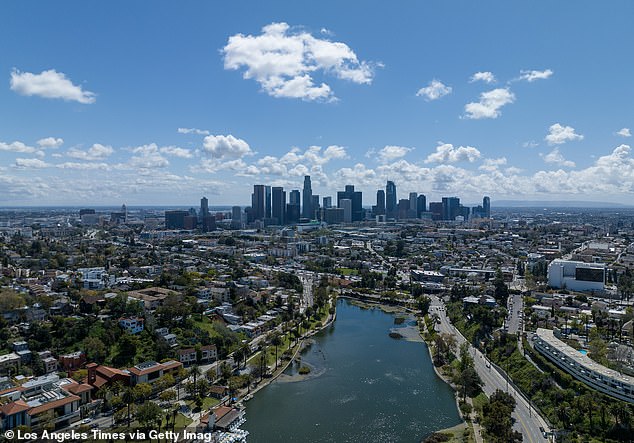Southern California has experienced three earthquakes in less than 12 hours, with two hitting about 10 minutes apart.
The US Geological Survey (USGS) detected the first at 4am ET and the others hit at about eight hours later, with the largest measuring a 3.3 magnitude.
While the weaker tremors measured a 2.7 magnitude, scientists noted the activity was strong enough to be felt by humans. No injuries or damages have been reported.
‘Southern California’s high level of seismic activity is a result of tectonic motion, which causes the northward progress of the Pacific plate (on the west) relative to the North American plate (on the east),’ the USGS shared in a statement.
‘The main plate-boundary fault is the San Andreas Fault, which stretches 745 miles from the Salton Sea in the south to offshore Cape Mendocino in the north.’
The USGS has received shaking reports from hundreds of locals in Los Angeles, Riverside and San Bernardino areas.
‘The San Andreas Fault can generate the region’s largest magnitude earthquakes (up to about M8.2),’ said the USGS.
‘The most recent ‘Big One’ on this fault in southern California was the M7.9 Fort Tejon earthquake of 1857, which was strongly felt throughout Los Angeles.’

The seismic activity happened miles outside of Los Angeles. Residents in the city reported shaking as the earthquakes hit
California is the third most seismically active US state, following Hawaii and Alaska.
Data shows that so far this year, California has experienced more than 14,000 tremors. While Alaska is nearing 60,000.
However, California experiences more earthquakes that cause damage due to its higher population and extensive infrastructure.
‘Southern California is also home to small areas of volcanic and geothermal activity, including Coso, north of Ridgecrest, and in the area south of the Salton Sea,’ the USGS said.
‘In these areas, hot fluid or magma is moving through the crust, causing local stresses and fracture movement.
‘These areas frequently experience seismic swarms, which are clusters of earthquakes that have no clear mainshock.
‘They may consist of many thousands of events and can last for hours, days, or years. Seismic swarms are also observed elsewhere in southern California, indicating localized movement of crustal fluids.’
Friday’s swarm comes a day after Northern California was rattled by multiple earthquakes.

The US Geological Survey (USGS) detected the first at 4am ET and the others hit at about eight hours later, with the largest measuring a 3.3 magnitude
The US Geological Survey (USGS) reported six tremors ranging in magnitude from 2.6 to 4.0.
Read More
EXCLUSIVE Ring of Fire ERUPTS as megaquake sets off huge volcanic chain reaction… and experts issue urgent warning: ‘Dynamic situation’

The seismic activity began at 1:51am ET, when four quakes occurred within just two minutes.
These quakes, roughly 72 miles north of San Francisco, struck near the San Andreas Fault, a massive 800-mile tectonic boundary stretching from Cape Mendocino to the Salton Sea.
Scientists have said that this fault is considered overdue for a ‘Big One,’ a magnitude 7.8 earthquake or higher, making the recent activity closely monitored.
The Maacama Fault, running north of Santa Rosa up to Ukiah, experienced a 3.9 magnitude quake.
This parallel fault system adds complexity to the region’s seismic activity, with experts suggesting the events may be part of a swarm or aftershock sequence.
And the latest tremor, a 3.6 magnitude, was detected in Southern California around 9:50am.
